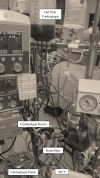The Impact of Roller Pump vs. Centrifugal Pump on Homologous Blood Transfusion in Pediatric Cardiac Surgery
- PMID: 28298664
- PMCID: PMC5347217
The Impact of Roller Pump vs. Centrifugal Pump on Homologous Blood Transfusion in Pediatric Cardiac Surgery
Abstract
Centrifugal pumps are considered to be less destructive to blood elements (1) when compared to roller pumps. However, their large prime volumes render them unsuitable as arterial pumps in heart lung machine (HLM) circuitry for children. In November of 2014, the circuit at Arnold Palmer Hospital, a Biomedicus BP-50 with kinetic assist venous drainage (KAVD) and 1/4″ tubing was converted to a roller pump in the arterial position with gravity drainage. Vacuum-assisted venous drainage (VAVD) was mounted on the HLM as a backup, but not used. Tubing was changed to 3/16″ in the arterial line in patients <13 kg. A retrospective study with a total of 140 patients compared patients placed on cardiopulmonary bypass (CPB) with Biomedicus centrifugal pumps and KAVD (Centrifugal Group, n = 40) to those placed on CPB with roller pumps and gravity drainage (Roller Group, n = 100). Patients requiring extra-corporeal membrane oxygenation (ECMO)/cardio-pulmonary support (CPS) or undergoing a hybrid procedure were excluded. Re-operation or circulatory arrest patients were not excluded. Prime volumes decreased by 57% from 456 ± 34 mL in the Centrifugal Group to 197 ± 34 mL in the Roller Group (p < .001). There was a corresponding increase in hematocrit (HCT) of blood primes and also on CPB. Intraoperative homologous blood transfusions also decreased 55% from 422 mL in the Centrifugal Group to 231 mL in the Roller Group (p < .001). The Society of Thoracic Surgeons--European Association for Cardio-Thoracic Surgery (STAT) categorized intubation times and hospital length of stay (LOS) for all infants showed a trend toward reduction, but was not statistically significant. Overall mortality was 5% utilizing the centrifugal configuration and 0% in the roller pump cohort. We demonstrated that the transition to roller pumps in the arterial position of the HLM considerably reduced our priming volume and formed a basis for a comprehensive blood conservation program. By maintaining higher HCTs on CPB, we were able to reduce intraoperative homologous blood transfusions.
Keywords: cardiopulmonary bypass; heart lung machine; kinetic assist venous drainage; modified ultra-filtration; vacuum-assisted venous drainage.
Figures











References
-
- Morgan L. S., Codispoti K., Sanger K., Mankad P. S.. Superiority of centrifugal pumps over roller pump in pediatric cardiac surgery: Prospective randomised trial. Eur J Cardiothorac Surg. 1998;13:526–32. - PubMed
-
- Paparella D., Brister S. J., Buchanan M.. Coagulation disorders of cardiopulmonary bypass: A review. Intensive Care Med. 2004;30:1872–81. - PubMed
-
- Rinder C. S., Bonan J. L., Rinder H. M., Mathew J., Hines R., Smith B. R.. Cardiopulmonary bypass induces leukocyte-platelet adhesion. Blood. 1992;79:1201–5. - PubMed
-
- Ojito J. W., Hannan R. L., Miyaji K., et al. . Assisted venous drainage cardiopulmonary bypass in congenital heart surgery. Ann Thorac Surg. 2001;71:1267–71. - PubMed
Publication types
MeSH terms
LinkOut - more resources
Full Text Sources
Medical
Research Materials
